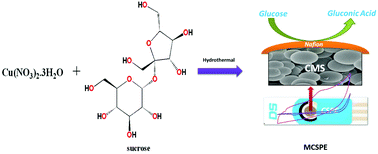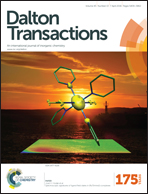Non-enzymatic amperometric sensing of glucose by employing sucrose templated microspheres of copper oxide (CuO)†
Abstract
We report a facile hydrothermal synthesis of copper oxide microspheres (CMS) for the enzymeless amperometric detection of glucose in an alkaline medium. The crystallinity, morphology and size were examined by powder X-ray diffraction (PXRD), scanning and transmission electron microscopy (SEM/TEM) and dynamic light scattering (DLS) techniques, respectively. The fabricated CMS were grafted onto the working area of a carbon screen printed electrode (CSPE) and covered with a thin Nafion layer (Nafion/CMS/CSPE), forming a modified carbon screen printed electrode (MCSPE) which acts as a working electrode. Further, the electrochemical behavior of MCSPE was investigated under optimized conditions through cyclic voltammetry (CV), electrochemical impedance spectroscopy (EIS), differential pulse voltammetry (DPV) and chronoamperometry (CA) techniques. The CV results showed a drastic enhancement of the current response in the presence of glucose. The amperometry results reveal the catalytic ability of CMS for glucose oxidation with a notable limit of detection (LOD) of 20.6 μM in a wide linear range of 2–9 mM with a high sensitivity of 26.59 μA mM−1 cm−2. Moreover, the anti-interference test confirmed the selectivity of the fabricated sensor towards glucose in the presence of interfering agents such as uric acid (UA), ascorbic acid (AA) and dopamine (DA).


 Please wait while we load your content...
Please wait while we load your content...